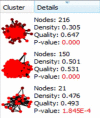Pancreatic adenocarcinoma protein-protein interaction network analysis
- PMID: 29511477
- PMCID: PMC5838186
Pancreatic adenocarcinoma protein-protein interaction network analysis
Abstract
Aim: Gene assessment of pancreatic adenocarcinoma disease via protein-protein interaction (PPI) Network Analysis.
Background: Diagnosis, especially early detection of pancreatic adenocarcinoma as a lethal disease implies more investigation. PPI Network Analysis is a suitable tool to discover new aspects of molecular mechanism of diseases.
Methods: In the present study the related genes to pancreatic adenocarcinoma are studied in the interactome unit and the key genes are highlighted. The significant clusters were introduced by Cluster-ONE application of Cytoscape software 3.4.0. The genes are retrieved from STRING date base and analyzed by Cytoscape software. The crucial genes based on analysis of central parameters were determined and enriched by ClueGO v2.3.5 via gene ontology.
Results: The number of 24 key genes among 794 initial genes were highlighted as crucial nodes in relationship with pancreatic adenocarcinoma. All of the key genes were organized in a cluster including 216 nodes. The main related pathways and cancer diseases were determined.
Conclusion: It was concluded that the introduced 24 genes are possible biomarker panel of pancreatic adenocarcinoma.
Keywords: Protein-Protein Interaction; biomarker panel; cluster; gene ontology; pancreatic adenocarcinoma.
Conflict of interest statement
The authors declare that they have no conflict of interest.
Figures




References
-
- Safaee A, Fatemi SR, Ashtari S, Vahedi M, Moghimi-Dehkordi B, Zali MR. Four years incidence rate of colorectal cancer in Iran: a survey of national cancer registry data - implications for screening. Asian Pac J Cancer Prev. 2012;13:2695–98. - PubMed
-
- Peyvandi AA, Khoshsirat S, Safaei A, Rezaei-Tavirani M, Azodi-Zamanian M. Interactome Analysis of 11-Dehydrosinulariolide-Treated Oral Carcinoma Cell Lines Such as Ca9-22 and CAL-27 and Melanoma Cell Line. Int J Cancer Manag. 2017;10:10096.
LinkOut - more resources
Full Text Sources
